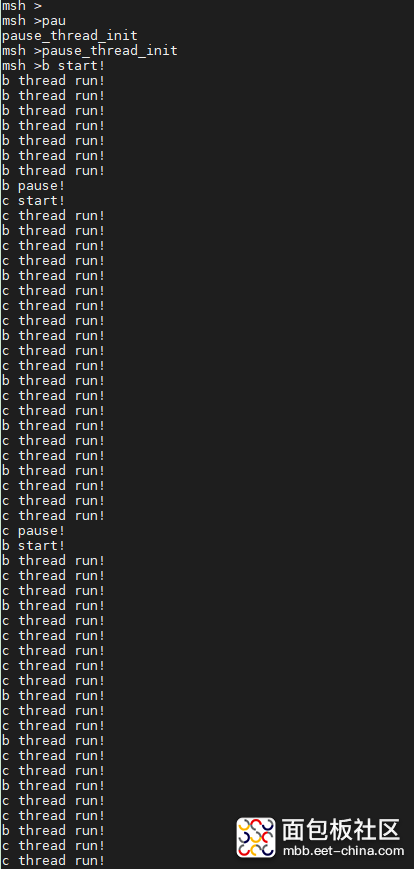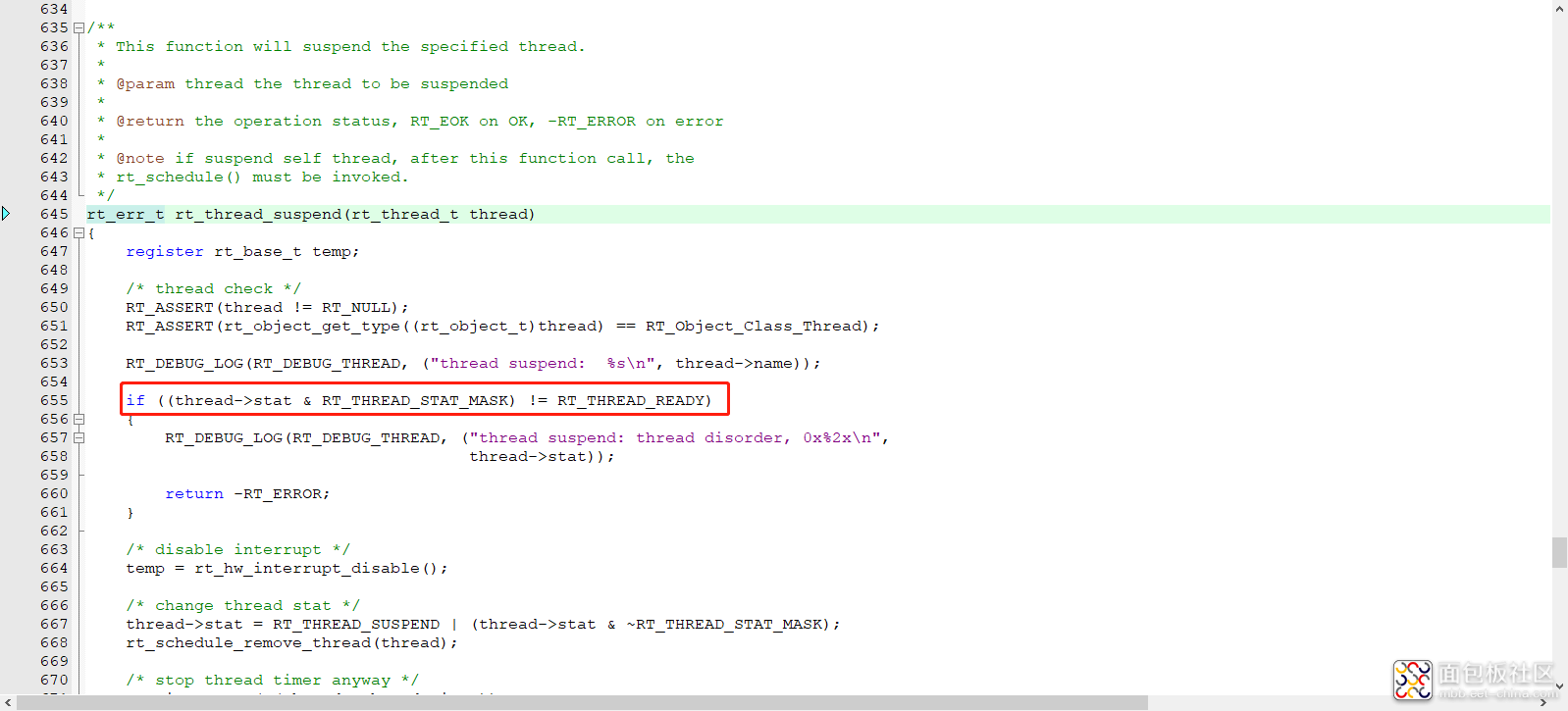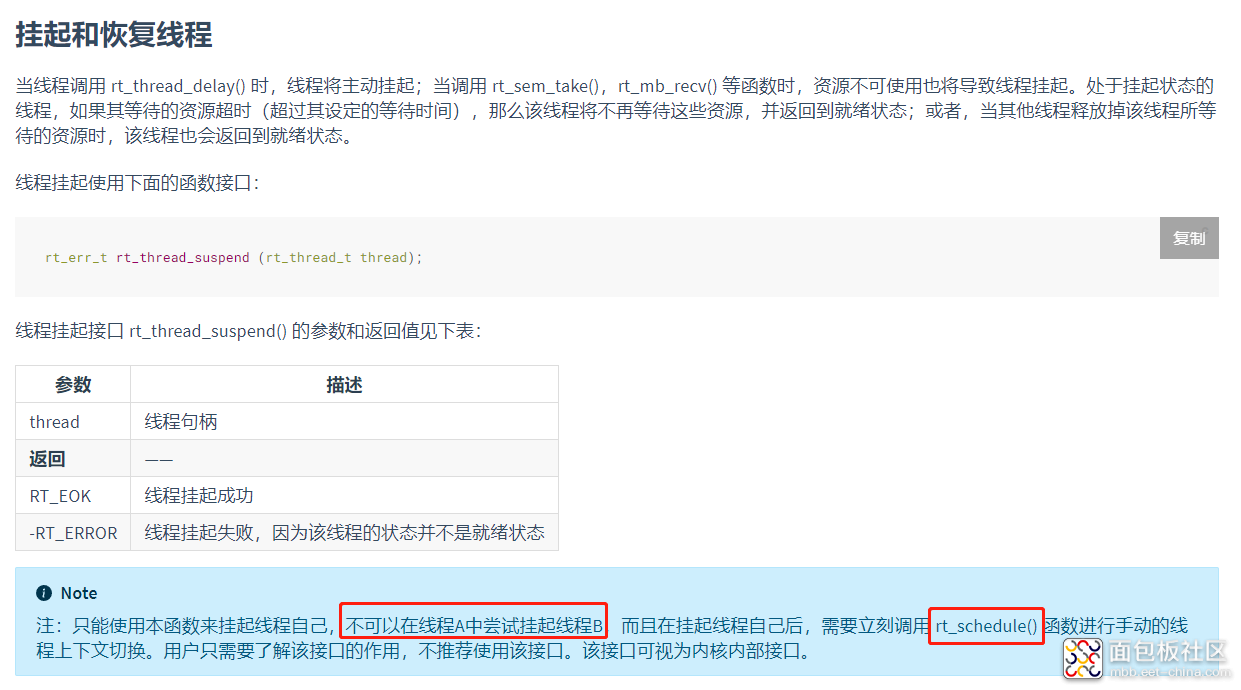本以为暂停线程是一条语句的事,结果发现事情并没有那么简单,而且我相信很多人都用错了,就是因为踩了这么一个坑,所以准备发这么一个帖子,让后面的人少踩坑。
2.应用场景
有三个线程,分别为A、B和C,把A线程比作是大脑,B和C线程分别是扫地和洗碗,首先处于空闲状态,大脑让我去扫地,这时A线程中会开启B线程,第一次开启线程可以调用【rt_thread_startup】这个函数,没啥毛病,当老婆大人让我去洗碗,大脑瞬间做出反应去洗碗,这时A线程会关闭B线程然后打开C线程,那么A线程关闭B线程是调用【rt_thread_suspend】这个函数吗?看着没啥问题哦,但是里面存在很大的问题!这里先不说,继续往下走,当洗完碗还得继续扫地,让A线程恢复B线程需要调用【rt_thread_resume】这个函数。
上面这个应用场景就实现了,A线程暂停和恢复B线程,看着是没什么问题,我们先来实际操作一下,看看有什么问题!
3.场景再现
硬件:STM32F407VET6
RTThread版本:3.1.3Nano
首先按照上面的应用场景走一遍,设计三个线程,分别为A、B和C,然后开始运行,具体代码如下:
#include <rtthread.h>ALIGN(RT_ALIGN_SIZE) static rt_uint8_t a_thread_stack[ 512 ]; ALIGN(RT_ALIGN_SIZE) static rt_uint8_t b_thread_stack[ 512 ]; ALIGN(RT_ALIGN_SIZE) static rt_uint8_t c_thread_stack[ 512 ]; static struct rt_thread a_thread; static struct rt_thread b_thread; static struct rt_thread c_thread; static void a_thread_entry(void *parameter) { unsigned int count = 0; while (1) { count++; if(count == 10) { rt_kprintf("b start!\n"); rt_thread_startup(&b_thread); //开始扫地 } else if(count == 30) { rt_kprintf("b pause!\n"); rt_thread_suspend(&b_thread); //停止扫地 rt_kprintf("c start!\n"); rt_thread_startup(&c_thread); //开始洗碗 } else if(count == 50) { rt_kprintf("c pause!\n"); rt_thread_suspend(&c_thread); //停止洗碗 rt_kprintf("b start!\n"); rt_thread_resume(&b_thread); //开始扫地 } rt_thread_delay(100); } } static void b_thread_entry(void *parameter) { unsigned int count = 0; while (1) { rt_kprintf("b thread run!\n"); rt_thread_delay(300); } } static void c_thread_entry(void *parameter) { unsigned int count = 0; while (1) { rt_kprintf("c thread run!\n"); rt_thread_delay(100); } } int pause_thread_init(void) { rt_err_t result; /* init led thread */ result = rt_thread_init(&a_thread, "a_thread", a_thread_entry, RT_NULL, (rt_uint8_t *)&a_thread_stack[0], sizeof(a_thread_stack), 5, 5); if (result == RT_EOK) { rt_thread_startup(&a_thread); } /* init led thread */ result = rt_thread_init(&b_thread, "b_thread", b_thread_entry, RT_NULL, (rt_uint8_t *)&b_thread_stack[0], sizeof(b_thread_stack), 6, 5); /* init led thread */ result = rt_thread_init(&c_thread, "c_thread", c_thread_entry, RT_NULL, (rt_uint8_t *)&c_thread_stack[0], sizeof(c_thread_stack), 7, 5); return 0; } /* 导出到 msh 命令列表中 */ MSH_CMD_EXPORT(pause_thread_init, pause thread);
复制代码
图1
这是为什么呢?我们上RTThread官网看一下,观看图2可以发现【rt_thread_suspend】的函数说明中,特意的说明了这个函数不能通过A线程挂起B线程。

图2
同时我也上网查了一下,大家都有这个疑问,然后我们翻开源码看一下,在这个函数中有这么一个判断,会判断需要挂起线程的状态,如果线程不等于就绪态那么就不会进入挂起,而sleep,delay等函数都会导致线程的挂起,那么其他线程想要挂起这个线程肯定会掉到这个if里面,从而挂起不了这个线程。

图3
4.解决方案
可以使用删除线程和创建线程的方式来停止线程的运行,但是这个对线程有一定的要求,比如线程没有运行时长的变量,如果有的话,线程删除了这个变量的值也会被复位,要么这个变量设置为全局变量,但是这样就不太合适,代码实现如下所示:
#include <rtthread.h>ALIGN(RT_ALIGN_SIZE) static rt_uint8_t a_thread_stack[ 512 ]; ALIGN(RT_ALIGN_SIZE) static rt_uint8_t b_thread_stack[ 512 ]; ALIGN(RT_ALIGN_SIZE) static rt_uint8_t c_thread_stack[ 512 ]; static struct rt_thread a_thread; static struct rt_thread b_thread; static struct rt_thread c_thread; static void b_thread_entry(void *parameter); static void c_thread_entry(void *parameter); static void a_thread_entry(void *parameter) { unsigned int count = 0; while (1) { count++; if(count == 10) { rt_kprintf("b start!\n"); /* init led thread */ rt_thread_init(&b_thread, "b_thread", b_thread_entry, RT_NULL, (rt_uint8_t *)&b_thread_stack[0], sizeof(b_thread_stack), 6, 5); rt_thread_startup(&b_thread); //开始扫地 } else if(count == 30) { rt_kprintf("b pause!\n"); rt_thread_detach(&b_thread); //停止扫地 rt_kprintf("c start!\n"); rt_thread_init(&c_thread, "c_thread", c_thread_entry, RT_NULL, (rt_uint8_t *)&c_thread_stack[0], sizeof(c_thread_stack), 7, 5); rt_thread_startup(&c_thread); //开始洗碗 } else if(count == 50) { rt_kprintf("c pause!\n"); rt_thread_detach(&c_thread); //停止洗碗 rt_kprintf("b start!\n"); rt_thread_init(&b_thread, "b_thread", b_thread_entry, RT_NULL, (rt_uint8_t *)&b_thread_stack[0], sizeof(b_thread_stack), 6, 5); rt_thread_startup(&b_thread); //开始扫地 } rt_thread_delay(100); } } static void b_thread_entry(void *parameter) { unsigned int count = 0; while (1) { rt_kprintf("b thread run!\n"); rt_thread_delay(300); } } static void c_thread_entry(void *parameter) { unsigned int count = 0; while (1) { rt_kprintf("c thread run!\n"); rt_thread_delay(100); } } int pause_thread_init(void) { rt_err_t result; /* init led thread */ result = rt_thread_init(&a_thread, "a_thread", a_thread_entry, RT_NULL, (rt_uint8_t *)&a_thread_stack[0], sizeof(a_thread_stack), 5, 5); if (result == RT_EOK) { rt_thread_startup(&a_thread); } return 0; } /* 导出到 msh 命令列表中 */ MSH_CMD_EXPORT(pause_thread_init, pause thread);
复制代码
图4
这里我推荐使用信号量的方法来暂停线程,首先定义一个暂停信号量,然后在需要暂停的线程中去不停的监测这个信号量,当接收到信号量时,自己主动挂起线程并让出CPU,这样就可以实现暂停线程,而且还能够知道线程暂停在哪。代码实现如下:
#include <rtthread.h>ALIGN(RT_ALIGN_SIZE) static rt_uint8_t a_thread_stack[ 512 ]; ALIGN(RT_ALIGN_SIZE) static rt_uint8_t b_thread_stack[ 512 ]; ALIGN(RT_ALIGN_SIZE) static rt_uint8_t c_thread_stack[ 512 ]; static struct rt_thread a_thread; static struct rt_thread b_thread; static struct rt_thread c_thread; static rt_sem_t b_pause_sem = RT_NULL; static rt_sem_t c_pause_sem = RT_NULL; static void a_thread_entry(void *parameter) { unsigned int count = 0; while (1) { count++; if(count == 10) { rt_kprintf("b start!\n"); rt_thread_startup(&b_thread); //开始扫地 } else if(count == 30) { rt_kprintf("b pause!\n"); rt_sem_release(b_pause_sem);//rt_thread_suspend(&b_thread); //停止扫地 rt_kprintf("c start!\n"); rt_thread_startup(&c_thread); //开始洗碗 } else if(count == 50) { rt_kprintf("c pause!\n"); rt_sem_release(c_pause_sem);//rt_thread_suspend(&c_thread); //停止洗碗 rt_kprintf("b start!\n"); rt_thread_resume(&b_thread); //开始扫地 } rt_thread_delay(100); } } static void b_thread_entry(void *parameter) { unsigned int count = 0; while (1) { rt_kprintf("b thread run!\n"); rt_thread_delay(300); if(rt_sem_take(b_pause_sem, 0) == RT_EOK) { rt_thread_suspend(&b_thread); //停止扫地 rt_schedule(); } } } static void c_thread_entry(void *parameter) { unsigned int count = 0; while (1) { rt_kprintf("c thread run!\n"); rt_thread_delay(100); if(rt_sem_take(c_pause_sem, 0) == RT_EOK) { rt_thread_suspend(&c_thread); //停止扫地 rt_schedule(); } } } int pause_thread_init(void) { rt_err_t result; b_pause_sem = rt_sem_create("b_pause", 0, RT_IPC_FLAG_PRIO); c_pause_sem = rt_sem_create("c_pause", 0, RT_IPC_FLAG_PRIO); /* init led thread */ result = rt_thread_init(&a_thread, "a_thread", a_thread_entry, RT_NULL, (rt_uint8_t *)&a_thread_stack[0], sizeof(a_thread_stack), 5, 5); if (result == RT_EOK) { rt_thread_startup(&a_thread); } /* init led thread */ result = rt_thread_init(&b_thread, "b_thread", b_thread_entry, RT_NULL, (rt_uint8_t *)&b_thread_stack[0], sizeof(b_thread_stack), 6, 5); /* init led thread */ result = rt_thread_init(&c_thread, "c_thread", c_thread_entry, RT_NULL, (rt_uint8_t *)&c_thread_stack[0], sizeof(c_thread_stack), 7, 5); return 0; } /* 导出到 msh 命令列表中 */ MSH_CMD_EXPORT(pause_thread_init, pause thread);
复制代码
图5
5.总结
希望RTThread能出一些更好暂停线程的方法,上述的方法只能作为应急使用,并不是最优的解决方案,A线程暂停B线程,这个场景是经常会使用到的,所以希望可以优化这个功能!








 /5
/5 

